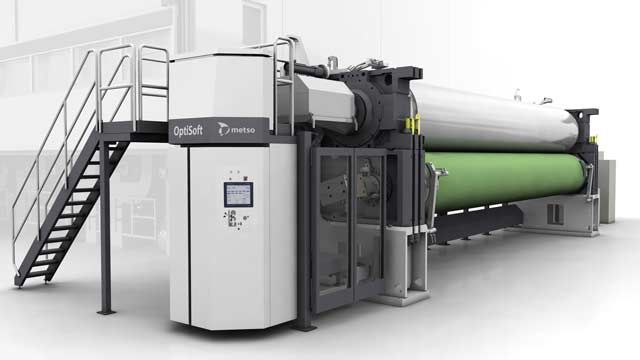Metso Develops Controller for Energy-Saving Digital Hydraulic System for Papermaking Equipment Using Model-Based Design
Challenge
Solution
Results
- Months of design time saved
- Weeks of customer startup time eliminated
- System reliability increased
“Using Model-Based Design with MATLAB and Simulink, we achieved multiple goals simultaneously. We developed a sophisticated controller for digital hydraulics that is more reliable, accurate, and efficient than previous systems, and we accelerated development, which gives us a competitive advantage.”

In industrial papermaking equipment, the calender rolls must be precisely controlled to achieve the right degree of smoothness and glossiness in the paper. Typically, roll positions must be maintained within a tolerance of 0.1 millimeters, and the pressure at the nip—the line of contact between rolls—must be within 0.2 bar of its set value.
Using Model-Based Design, Metso developed a digital hydraulic system that meets these requirements, consumes 98% less energy, requires less floor space, and is more reliable than the proportional hydraulic systems traditionally used for nip control.
“Model-Based Design with MATLAB and Simulink was instrumental in helping us reduce costs and improve quality because it enabled us to test and tune a complex controller design via simulation, rapidly implement a real-time prototyping system, and generate code for a production industrial controller PLC,” says Kari Leminen, general manager of automation technology at Metso.
Challenge
Metso wanted to streamline the development, testing, and production of controls for its first digital hydraulic system for advanced papermaking machinery.
While digital hydraulic systems require less energy and floor space than proportional hydraulic systems, they require much more complex controls. A digitally operated hydraulic cylinder can have 30 to 40 valves, and a single machine 20 or more cylinders, creating significant control requirements.
“With a proportional hydraulic system, it’s easy to set up a PID controller to adjust the valve position as needed,” says Ville Hopponen, technology engineer for automation at Metso. “A digital hydraulic system requires much more complicated mathematics in the controller, and programming mistakes are common when you are developing such a complex system.”
Metso needed an efficient way to produce a real-time prototyping system, a customer pilot implementation, and a production version of the digital hydraulics controller.
Solution
Metso engineers used Model-Based Design to develop a controller for the digital hydraulic system that precisely follows predefined targets for roll position, roll velocity, and nip pressure.
The initial control design was developed in cooperation with Tampere University of Technology’s Department of Intelligent Hydraulics and Automation.
University researchers modeled the control system and the digital valves in Simulink®. They modeled the calender frame and other aspects of the plant with Simscape Multibody™, and conducted closed-loop simulations in Simulink to verify the feasibility of the design.
Metso engineers enhanced the researchers’ initial model, adapting it for commercial use and adding fault tolerance, diagnostics, and status reporting features. After verifying the enhanced design in Simulink, Metso engineers used Simulink Coder™ to generate C code from their model, which they deployed to dSPACE® Simulator® hardware for real-time testing.
Test results were analyzed in MATLAB® and used to guide design refinements.
To produce the first customer pilot version, Metso switched from dSPACE to Simulink Real-Time™. During the process, the core Simulink model was unchanged; only input and output modules were updated to accommodate real-time communication with actual hardware.
Following the successful pilot programs, Metso engineers again switched their target, this time to a Beckhoff® programmable logic controller (PLC) using C code. The same core controller module was reused, with small changes made to I/O modules. Metso engineers are now using Model-Based Design for several other digital hydraulics projects.
Results
Months of design time saved. “By simulating the hydraulic systems and controls with our Simulink model instead of on hardware, we could explore fault conditions, valve configurations, and other design options much faster,” says Hopponen. “We shortened development further by reusing the model to generate code for testing prototypes and production PLCs.”
Weeks of customer startup time eliminated. “In the past it took weeks to tune parameters directly on the system at the customer site,” says Leminen. “With Model-Based Design we tune parameters in the model and on a real-time prototype, so when we get to the site we can start running the system almost immediately.”
System reliability increased. “Simulations in Simulink and real-time testing with Simulink Real-Time helped us deliver an exceptionally reliable control system,” says Leminen. “Our controller has proven more reliable than traditional systems, and has caused no down time in production, which is important because outages can cost €5,000 or more per hour.”